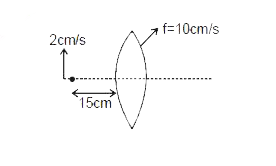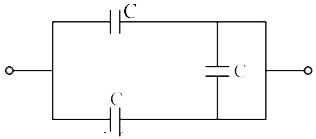See the figure
Find the equivalent focal length of the combination shown in the figure and position of image.

Video Solution
Text Solution
For the concave lens
1f=−(n−1)(1R1−1R2)=(32−1)(1−10−)−110)=12×210=110
And, fn=R2=102=5cm
∴1feq=1fm−21f
=15+2×110=25,feq=2.5cm
|
Topper's Solved these Questions
- GEOMATRICAL OPTICS BOOK - RESONANCECHAPTER - GEOMATRICAL OPTICS EXERCISE - Exercise-1
142 Videos
- GEOMATRICAL OPTICS BOOK - RESONANCECHAPTER - GEOMATRICAL OPTICS EXERCISE - Exercise-2
63 Videos
- GEOMATRICAL OPTICS BOOK - RESONANCECHAPTER - GEOMATRICAL OPTICS EXERCISE - Advance level Problems
35 Videos
- EXPERIMENTAL PHYSICSBOOK - RESONANCECHAPTER - EXPERIMENTAL PHYSICSEXERCISE - PART -II
10 Videos
- GRAVITATIONBOOK - RESONANCECHAPTER - GRAVITATIONEXERCISE - HIGH LEVEL PROBLEMS
16 Videos
Similar Questions
Knowledge Check
Find out equivalent focal length of given lens combination
_2019_CBT5_E01_036_Q01.png) A(Rμ1−μ2)B(2Rμ1−μ2)C(4Rμ1−μ2)D(Rμ1+μ2)
A(Rμ1−μ2)B(2Rμ1−μ2)C(4Rμ1−μ2)D(Rμ1+μ2)The equivalent capacitance of the combination show in figure is
 ACB2CC(C2)Dnone of these
ACB2CC(C2)Dnone of these
Findout the equivalent focal length of the combenation of lenses shown in the figure. Surrounding medium is air.

View SolutionFindout the equivalent focal length of the combenation of lenses shown in the figure. Surrounding medium is air.

View SolutionFindout the equivalent focal length of the combenation of lenses shown in the figure. Surrounding medium is air.

View SolutionFind the focal length fo the lens shown in the figure.

View SolutionThe equivalent capacitance of the combination shown in figure below is :

View SolutionFind the equivalent capacitance of the combination between A and B in the figure.

View Solution


